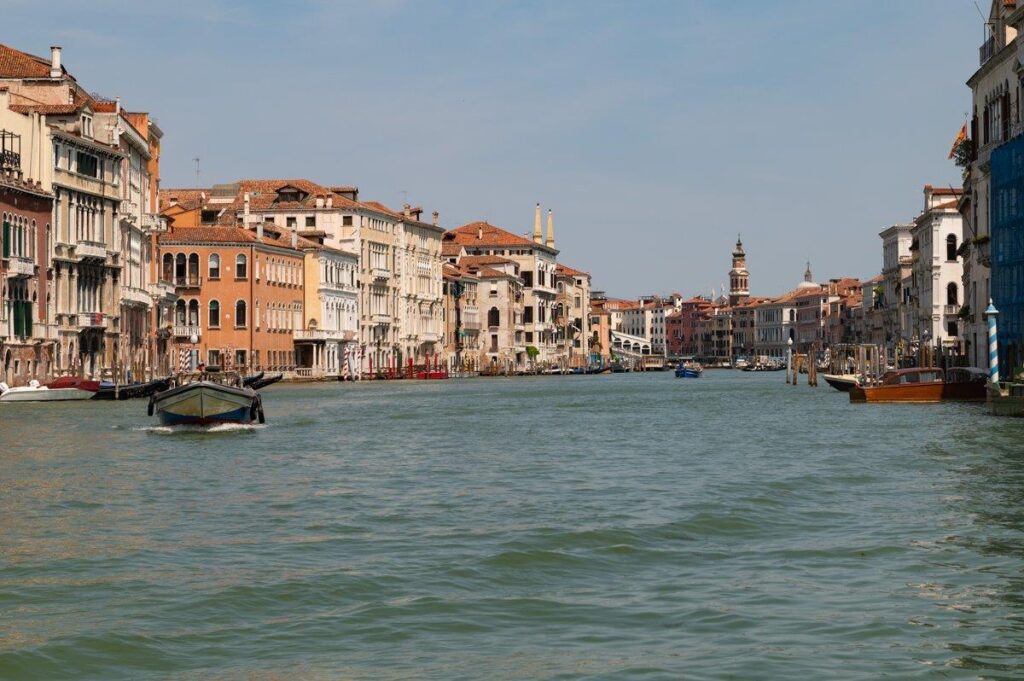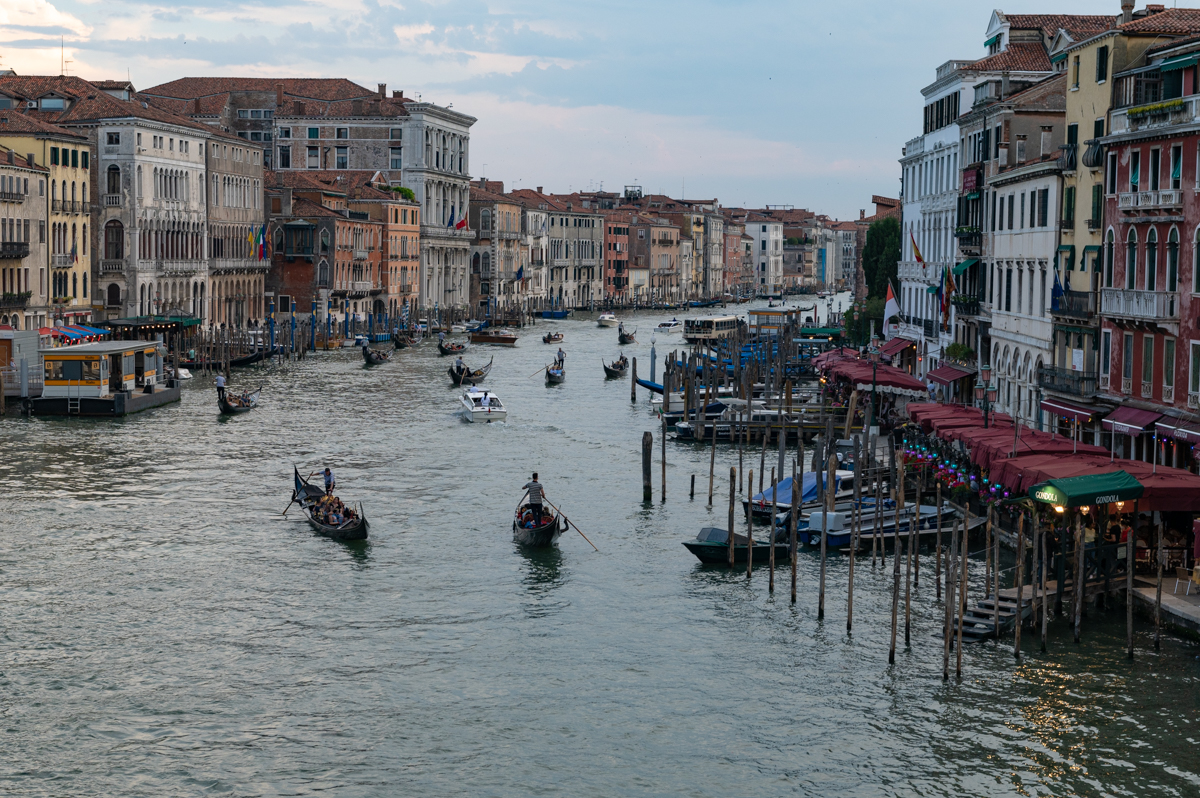“You Venetians live like sea birds, with your homes, now on sea and now on shore, dispersed across the surface of the water,” Cassiodorus wrote in the 5th century when he visited the North Western shores of the Adriatic sea. Much has changed since the days of the Romans. New peoples moved in. Murazzi, seawalls, have been built to enforce the lidi, natural sand banks that save the lagoon of Venice from the open sea; some scattered islands of the lagoon have been enlarged with wooden poles, so they grew into one island the shape of a fish, now a cobble-stoned city balancing above the waves. Saltwater runs through innumerable canals like blood through the arteries of a living being. But the Venetians still live like seabirds. Their palazzi are clad in clams and seaweed, and, like the doves and seagulls that cross the sky, they glide over the water, in all kinds of boats: in bulky chugging ferries and swift humming motorboats. And then, there are of course the gondolas that without a sound glide through the maze of narrow canals, slip under the little bridges, and pass by the wooden doors of splintered paint that lead straight into the water.
The iconic gondolas, black-lacquered, single-oar-steered boats, and their oarsmen, the gondoliers in their striped shirts, represent the history, the culture, the music, the spirit of Venice – but, sadly, their clichéd image of Serenaders for rich tourists and American honeymooners betrays the history of Venice’s oldest profession. Gondoliers are the guardians of the memory of the Serenissima, the once proud Venetian Republic, that before its downfall dominated the entire medieval world. Their songs are the long-faded lores of lovers, of bravi and courtesans, the secrets of Venice; songs of a thousand years, alas, unsung.
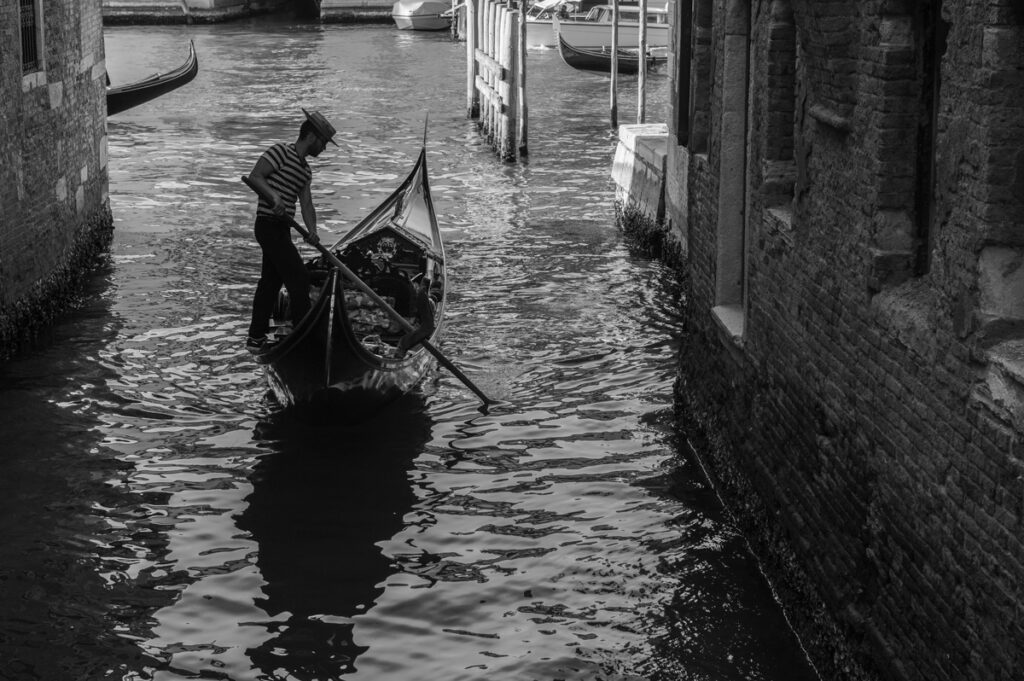
For two-thousand years, gondolas have changed little in size and design. Built from eight different kinds of wood, they are about ten metres long, slender and flat-bottomed, fit to manoeuver the shallow waters. They are asymmetrically built to counterbalance the oarsman’s weight. About a hundred years ago, they lost the little cabin – the felze – which provided the passenger with shelter from bad weather, and intimacy. But in essence, it is said, that a gondola still looks the same as the boat used by Charon, who ferried the souls into the underworld across the river Styx. This resemblance must have seemed obvious to many who visited Venice. Thomas Mann, for example. In his novel Death in Venice the protagonist arrived in the city by gondola, a foreboding of the novel’s eponymous ending.
How black a gondola is – / black, coffin-black, /
a vision of death itself / and the last silent voyage
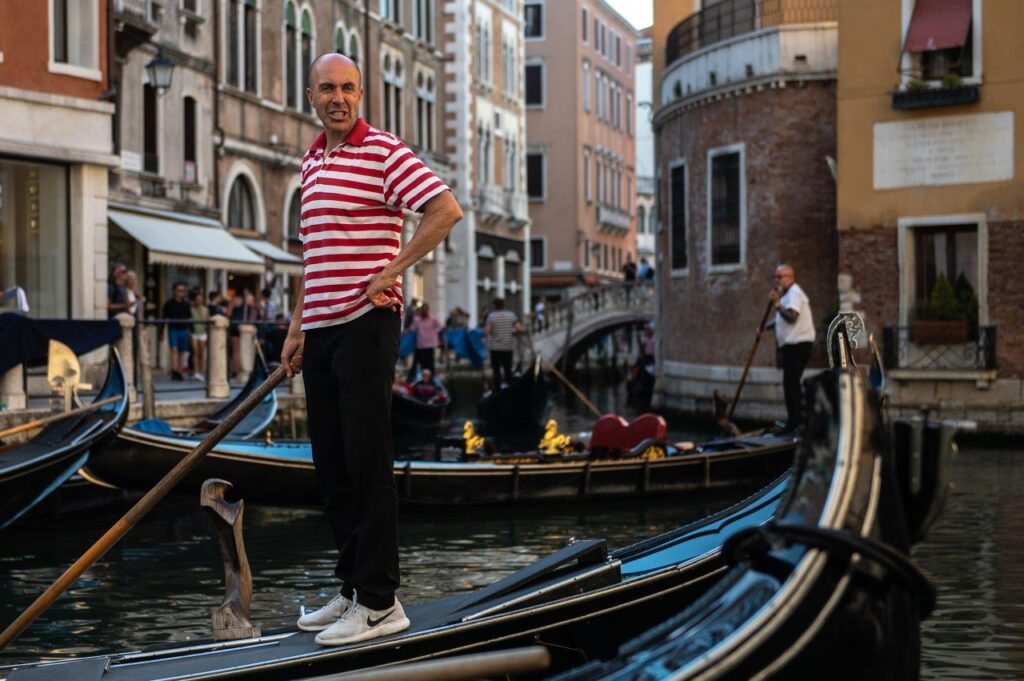
For Goethe, who visited Venice long before Mann in the 18th century, a gondola ride was the journey of life, complete from birth to death:
I compare this gondola to a gently rocking cradle,
And the little cabin appears a spacious coffin.
Rightly so! For between cradle and coffin we sway
And hover carefree along the Grand Canal of life.
But all this was this a cultural misunderstanding. That gondolas are painted black has nothing to do with death. Rather, in Venice, black signifies elegance (red stands for grief and death), and they weren’t always black.
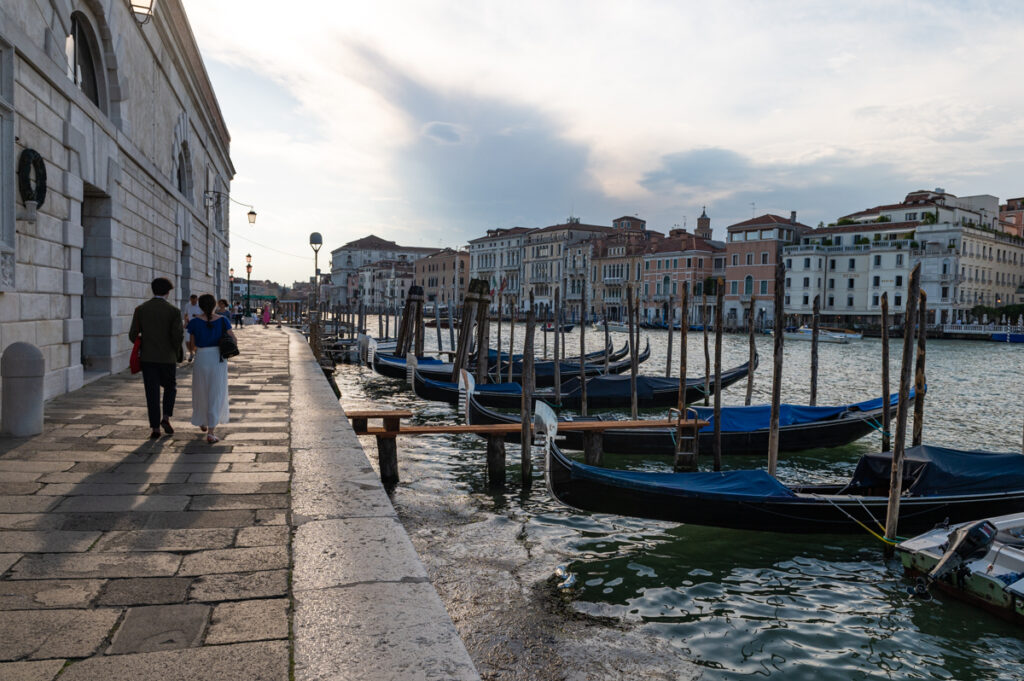
Initially, the rich very well tried to outdo each other by lavishly decorating their gondolas. However, in 1562, a sumptuary law was passed that prevented them from spending money on their gondolas. Instesad they were taxed heavily. The Republic needed money and a war to be fought. The Ottomans were advancing, having sacked Constantinople already, spreading fear and terror across Europe. The Ottoman’s gory campaign along the Adriatic cost was only stopped in 1571 at the Battle of Lepanto – which left the Venetians battered, but victorious. In an ensuing wave of patriotic enthusiasm inspired Torquato Tasso to his epic Gerusalemma Liberata, and turned the gondolas forever black. Cheaper maybe, but sexy, too.
“The gondola’s gliding too was absolutely noiseless. In fact there was something distinctly erotic in the noiseless and traceless passage of its lithe body upon the water – much like sliding your palm down the smooth skin of your beloved. Erotic, because there were no consequences, because the skin was infinite and almost immobile, because the caress was abstract. … In fact, it was an eroticism not of gender, but of elements, a perfect match of their equally lacquered surfaces.“
Russo-American writer Joseph Brodsky wrote in his essay Watermarks of 1973. It was his only gondola ride, a short cruise through cold, nocturnal Venice in winter. Other poets, like Henry James, who visited the city around the fin de siècle, had also remarked on the sensual pleasures of riding a gondola:
Gondolas spoil you for a return to common life. To begin with, in themselves they afford the perfection of indolent pleasure. The seat is so soft and deep and slumberous and the motion so mild, elastic and unbroken that even if they bore you through miles of stupid darkness you’d think it the most delectable fun,” he wrote home.
But also for Brodsky, his one nightly ride was a transcendental experience:
“There is something primordial about traveling on water, even for short distances. You are informed that you are not supposed to be there not so much by your eyes, ears, nose, palate, or palm as by your feet, which feel odd acting as an organ of sense. Water unsettles the sense of horizontality, especially at night, when its surface resembles pavement.”
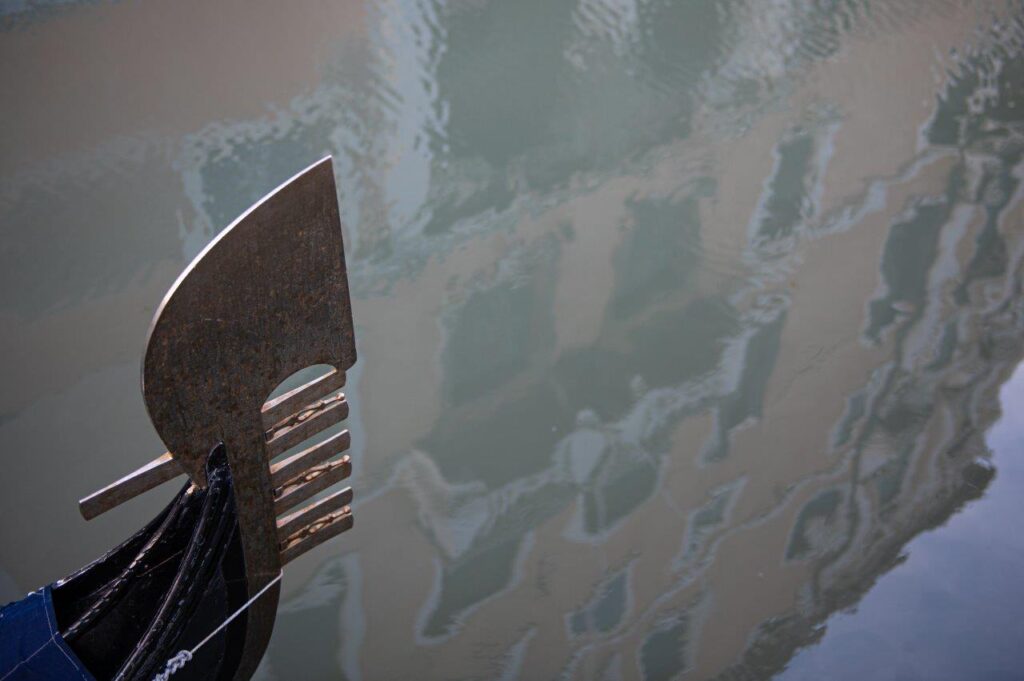
From the vantage point of a gondola, not the boat, but the world sways. The city shifts into water, and hard matter melts into insubstantiality. What was once a reality is suddenly but a possibility. Is this a liberation from reality, or just the surreal distortion of a dream? Or is a drifting away, like a slow, tender death? And in deed, the city is sinking.
The level of water relative to land in Venice is nearly 40 centimetres higher than it was in 1897, when scientific measurements began. Less than half of that is due to subsidence from the rivers pouring into the lagoon – the bigger part is owed rising sea levels. The lidi, which once saved Venice from the fierce Southern winds and hostile attacks, cannot protect Venice from climate change.

At sea-level, Venice is two-fold. There is one city outlined sharply against the backdrop of the azure Mediterranean sky, or the saffron setting sun: The voluptuous oriental cupolas of St. Marks, the virile towers of the 139 churches, the little hooded chimneys of the houses and palazzi. Then there is a second city, blurred, against the black backdrop of the water, where curtained windows are dancing, swaying doors are opened by ghost hands, and closed again.
The city is many-fold. It comes as no surprise that the mirror was invented in Venice. (at least as far as Europe is concerned. The Chinese had used mirrors for centuries, and the idea was brought to Venice by Marco Polo.) For the Italian writer Italo Calvino Venice was an imagined city: “From one part to the other, the city seems to continue, in perspective, multiplying its repertory of images’ it is the “endless city of imagination.” What is life like, spent at the threshold of these two cities, two worlds, many worlds?
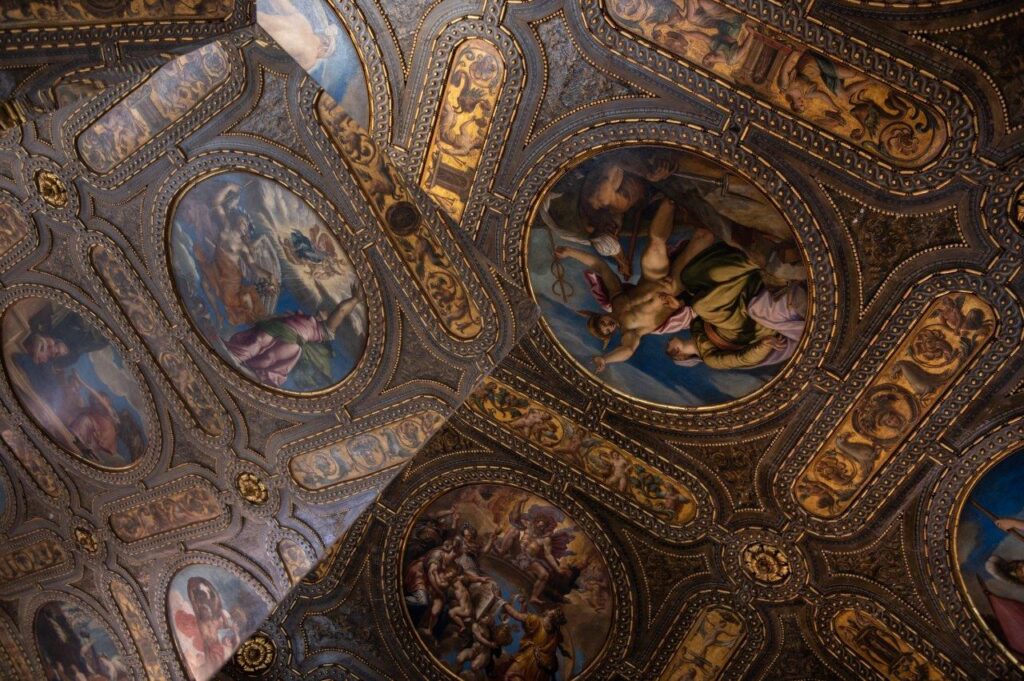
“Traditions and instincts of republican Venice endure with greatest tenacity among the gondoliers… They, more than any other institution of Venice, have successfully withstood the changes and chances of progress,” Scottish historian Horatio F. Brown stated in his book “Life on the Lagoons,” published in 1909. As long as there was Venice, there were gondoliers who transported the city dwellers from door to door, to the sourrounding little islands that were used to grow crop or separate the sick, to the opera houses, to the churches, to the magistrates, the casinos and brothels. As private drivers, as ferrymen, and, later, as maritime taxi drivers, they were confidantes in secret love affairs, and partners in crimes. At times, they even were the criminals themselves.
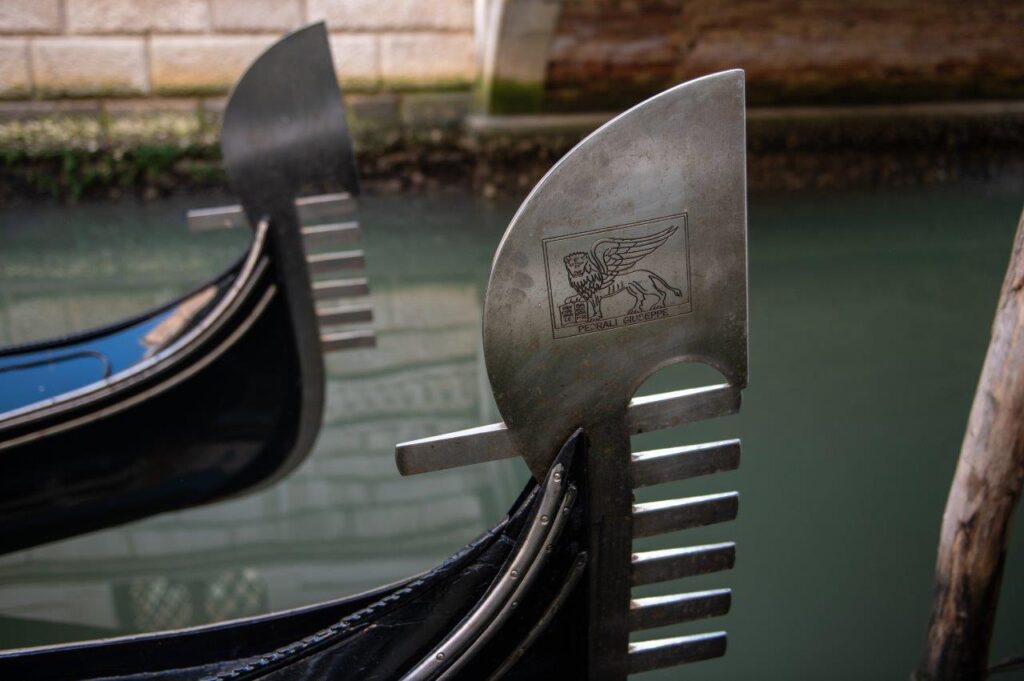
The fierce lion of the Serenissima Repubblica, reflected in the water of the lagoon, turns into a gondolier. Gondoliers carry with them the other side of Venice, not the one of Doges, trade and warfare. They have their own language, a mixture of Italian dialects and different languages as initially the majority of gondoliers stemmed from the Eastern Adriatic countries. This secret languages enables the gondoliers to to exchange deprecatory remarks about their paying passengers without these realizing. Taking a closer look, gondoliers resemble the traditional folkloric characters like Pinocchio, Zani, Arlequino, Pulcinella who in their subversive truculent renitence are equally representative of the local patois and the entire peninsula. A symbol to unify a country that was only reluctantly unified.
The republic of Italy was born in 1864. Like the Lombards, the Florentines, the Neapolitans, and all the other city states on the peninsula, the Venetians were asked to exchange their Venetian identity for Italian citizenship. Symbols to create a nation were needed, and in the 19th century, the romantic period, gondoliers were a welcome symbol of Italianita. Yet, with tourism growing steadily in Vencie, and with the local sense of business and profit, somewhere down the line the gondolier shifted from icon to mascot.
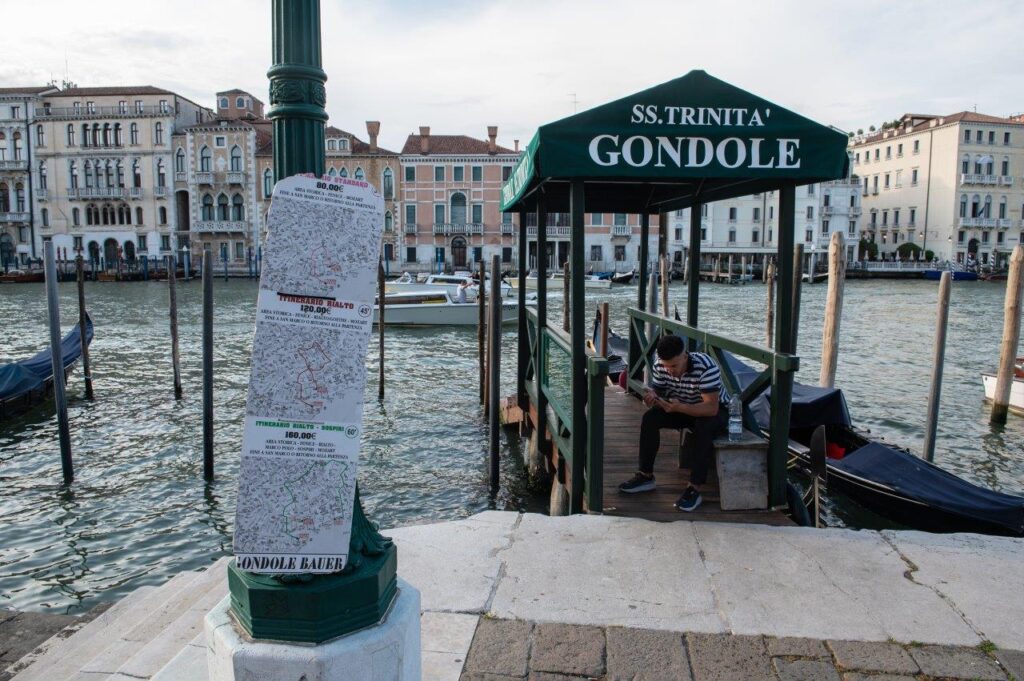
Like religious faith, the job of a gondolier is hereditary. Both gondola and the gondolier’s license are passed on when the father retires. (It’s always the father. Women have been barred from the profession until recently and at present day there are only four of female gondoliers in Venice.) Any other neophyte first needs to come up with the cash to pay for a gondola (€30,000 – 40,000) then enroll in gondolier-school, where, besides the technicalities of sea navigation and the physical abilities to safely steer the wobbly gondola with only one heavy oar, subjects like art history, English and Spanish, are taught. The final exam the so-called vola di poppa is so rigorous that most fail at first attempt. It is the gondolier’s guild that makes it hard for anyone to join the club. Gondoliers are free-lancers. But their guild looks out for them. Theirs is powerful guild that goes back a thousand years.
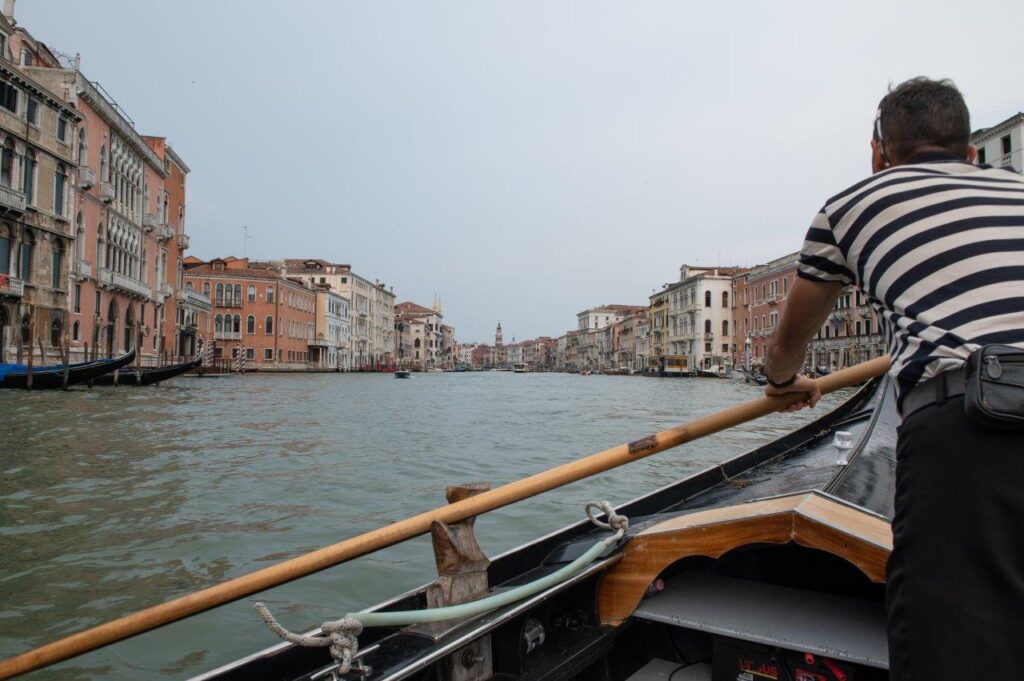
Traditionally, like a true catholic fraternity, guild members supported each other financially. The guild looked after gondoliers’ wives and children should one of them fall ill, and should one die, funeral costs were paid. In the 17th century, the gondoliers hence founded their own bank (Venetians invented matter of fact-ly the banking system.) Shifts and routes were evenly distributed among the members, whose number is restricted, currently to 433.
The guild’s organizational structure was as complicated as the set-up of the Venetian government, the Signoria. Like the Doge, the guild’s chief officer – the gastaldo – and his assistants – the bancali – were elected by the blindfold drawing from a ballot with the names of all members inside. The main difference to the Venetian Signoria was that the gondoliers didn’t want to be drawn. Their dislike of administrative duties and responsibilites sometimes went so far that elected members went into hiding for the length of their term, as the Horatio F. Brown tells in Life On the Lagoons, which lead to corruption and mismanagement especially as far as the traghetti were concerned.
Traghetti are the short but lucrative gondola passages that cross the Canale Grande. At one point the traghetti started selling or renting out licenses for personal enrichment. The result was that gondoliers were soon joined or replaced by bravi – gangsters. Soon the gondolas became dangerous to passengers, as …the young ruffians armed themselves, and exacted their fares by threats, or compelled the citizens to pay, a modo loro, by driving them forcibly on board their gondolas, taking them into the mid canal and feigning to upset the boat, until the soldi were forth coming.
Hence, strict rules were implied, like the 1702 barring of knives or pistols on board, punishable with whiplashes, or even the banishment from Venice.
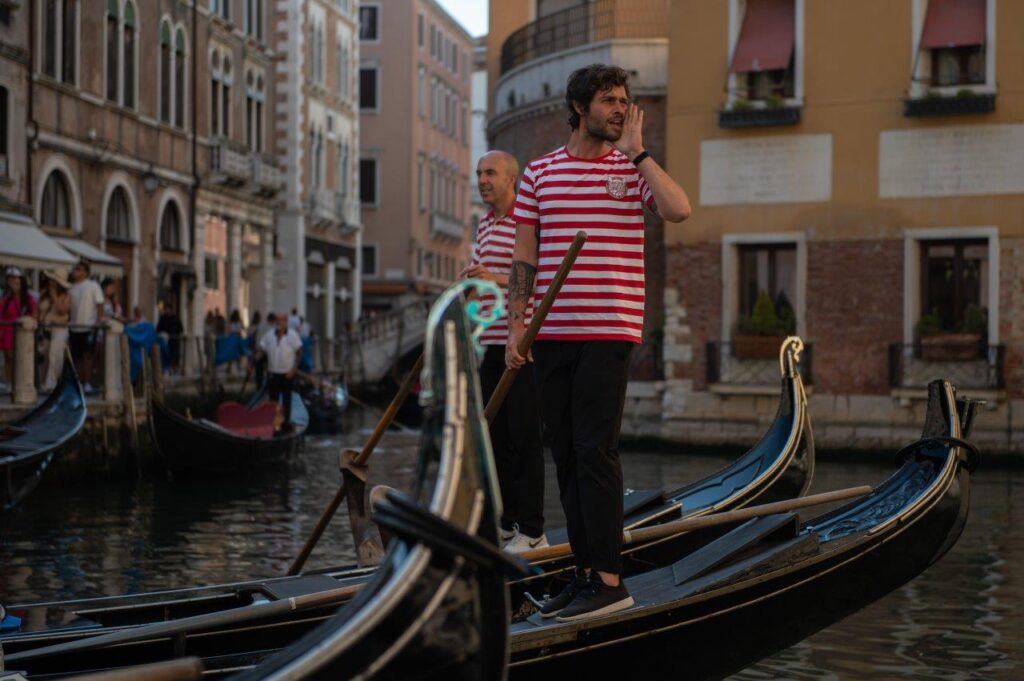
It may be stories like this one, why gondoliers are more popular among tourists than among locals.
“The one thing the locals never do is ride gondolas. To begin with, a gondola ride is pricey. Only foreign tourists, and well-off ones at that, can afford it. That’s what explains the median age of gondola passengers: a septuagenarian can shell out one-tenth of a schoolteacher’s salary without wincing. The sight of these decrepit Romeos and their rickety Juliets is invariably sad and embarrassing, not to say ghastly. For the young, i.e., for those who this sort of thing would be appropriate, a gondola is as far out of reach as a five-star hotel. Economy, of course, reflects demography; yet that is doubly sad, because beauty, instead of promising the world, gets reduced to being its reward.” Joseph Brodsky wrote in Watermark.
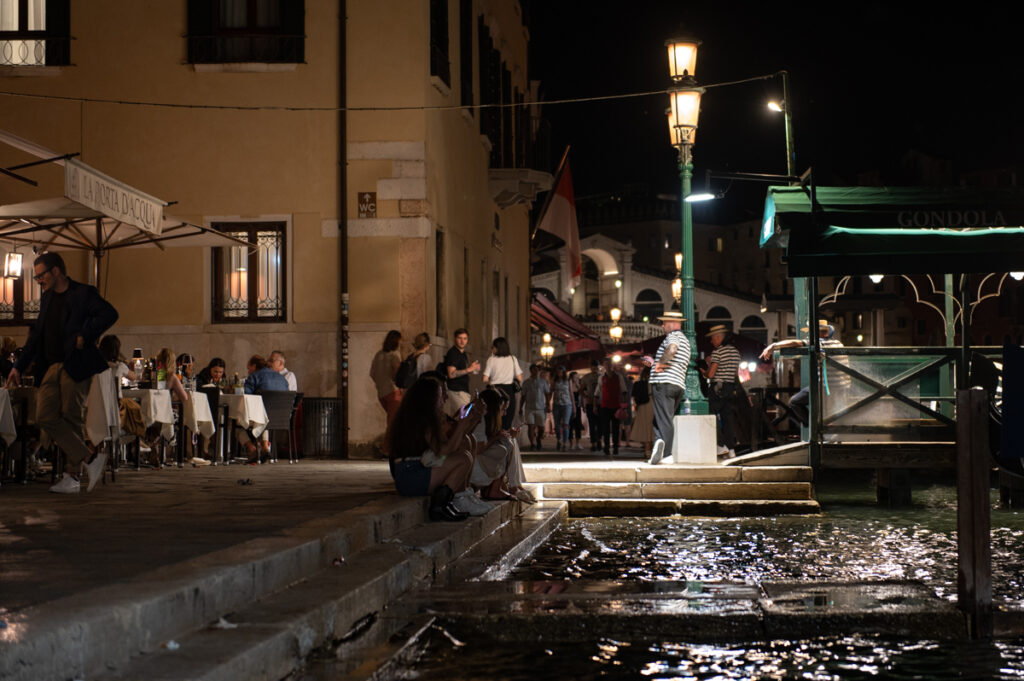
Venice recognized tourism as an important source of income early on, relying not only on the city’s rich heritage in art, her flamboyant churches and vibrant opera houses, but also on the lax vice laws. To further encourage tourism, Venice had extended Carneval-season and the wearing of masks to half a year, starting beginning of October, thereby granting anonymity to the patrons of brothels and casinos. Courtesans and prostitutes of all ages and genders were so numerous a register was issued to help tourists their way around. No wonder Venice drew masses of young gentlemen from countries with strict moral codices, like England, Germany, and France, who visited Venice on their Grand Tour, their Bildungsreise. To them, Venice meant temporary freedom and erotic adventures. After all, it was only the gondoliers who knew who hid behind the masks, who knew when the hearts flared up, and who knew when the hearts broke.
Like that of Henry James’s disappointed lover Constanze. Rejected by the English poet, he himself more drawn towards his own sex, she committed suicide by throwing herself from her window down the passage. The poet, concerned about his reputation, tried to erase all traces that led to him, and rode out into the lagoon with Constanze’s gondolier, sinking her clothes in the furthest and deepest part of the lagoon. The same gondolier, Angelo Fusato, is rumoured to have later entertained a romantic relationship with the English poet John Addington Symonds. “The powerful and radiant manhood of the splendid animal was intertwined with sentiment for Venice, a keen delight in the landscape of the lagoons, and something penetrative and pathetic in the man.” Symonds wrote about Fusato.
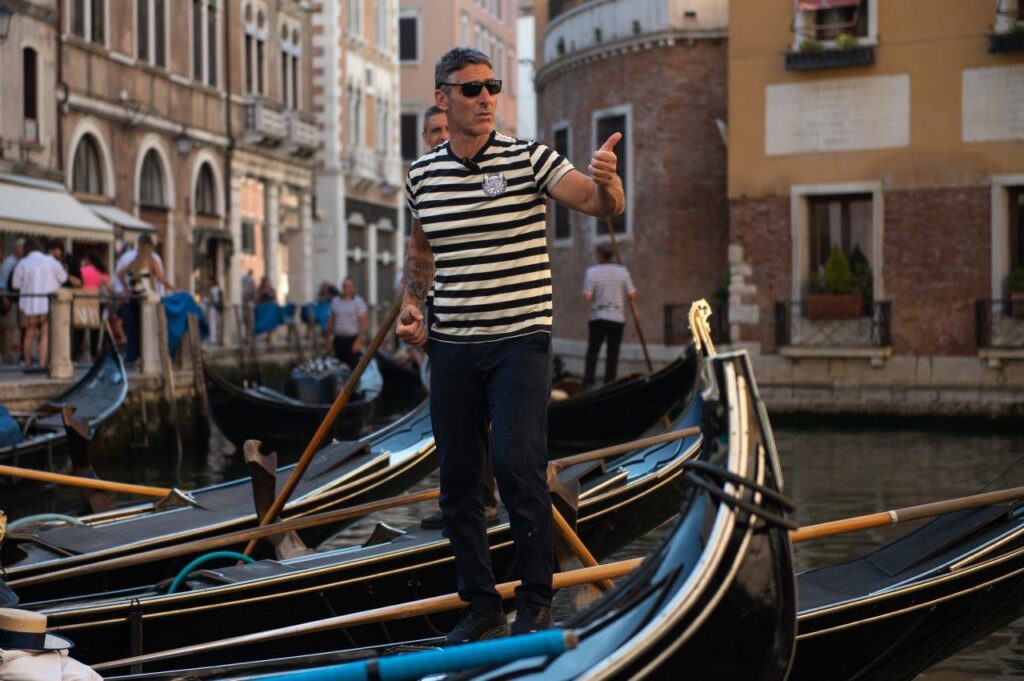
If in Symond’s eyes, the gondolier and the city are as inseparable as the gondolier and his gondola, then he delivered the most beautiful, and maybe truest descriptions of 19th century Venice.
“Angelo’s eyes as I met them had the flame and vitreous quality of opals, as though the quintessential colour of Venetian waters were vitalized in them and fed from inner founts of passion… He was careless by nature, poor by circumstances, determined to have money, indifferent to how he got it. Besides, I know from what he has since told me that the gondoliers of Venice are so accustomed to these demands that they think little of gratifying their caprices of ephemeral lovers – within certain limits, accurately fixed according to a conventional but rigid of code of honour in such matters.”
According to the German poet August von Platen, it was customary for foreigners to form romantic relationship with impoverished Venetians, often gondoliers, and support them and their families. Symonds supported his Angelo, and thereby enabled him to marry his mistress.
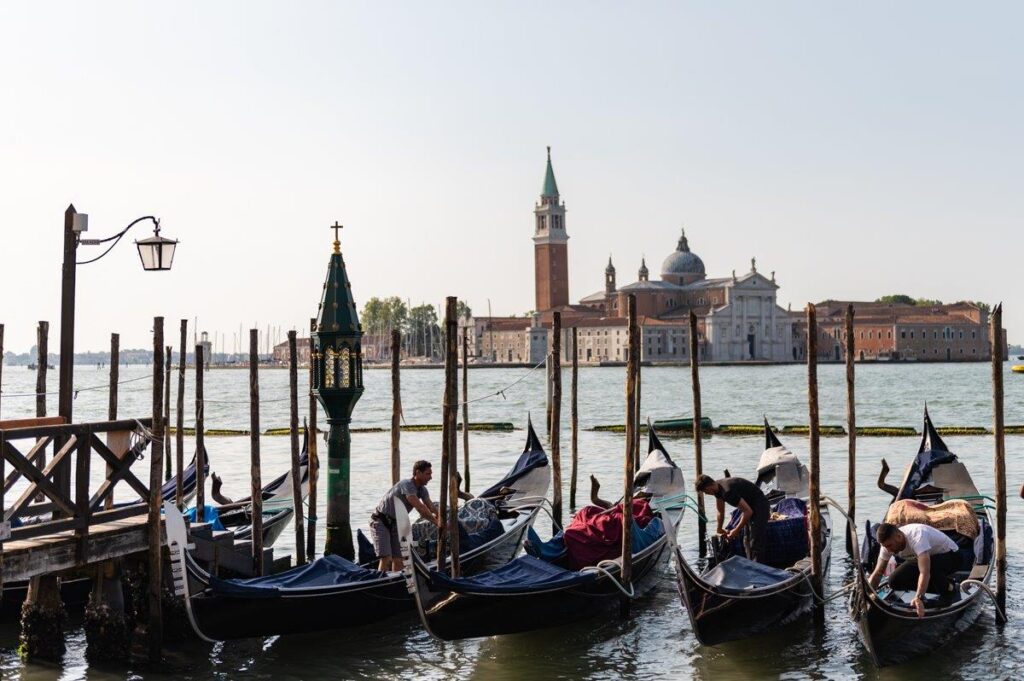
When in the 18th century Jean-Jacques Rousseau arrived in the city, he, too, developed a great interest in the gondoliers. He remained immune to their opal eyes, but was smitten by their songs. Their ballads reminded him of the opera arias popular at the time, but were lighter, not as sophisticated, and therefore much more sensual, hypnotic even. In his Dictionary of Music he would later call them Barcarolle – songs from the boats.
“No poet has been sung as much as Tasso in Venice, save by the gondoliers, and they are surely not the greatest of readers,” Rousseau wrote. This of course meant, that the 16th century poet Torquato Tasso must have been sung without interruption since then, making the gondoliers as important guardians of Venice’s history, an essential part of the city’s oral tradition.
Most of the gondoliers’ songs were indeed a sort of a parody, or plagiarism of, or at least inspired by the “serious” love arias. When waiting for their padroni or passengers, Gondoliers were allowed to enter theatres for free, and then, on the way home, they entertained their passengers by singing in the style of the respective opera, in Venetian, Italian, in French or some entirely foreign gibberish. Eventually, these songs were written down, and became part of gondoliers’ repertory.
Even Goldoni is rumored to have chipped in a few songs to be performed in boats during carnival processions, which were plenty, since carnival lasted six months each year. Yet he preferred to remain anonymous given the racy character of this pop-ular music. So-called love songs they emphasized the advantages of the more ephemeral, non-committal style of romance, in other words: sex.
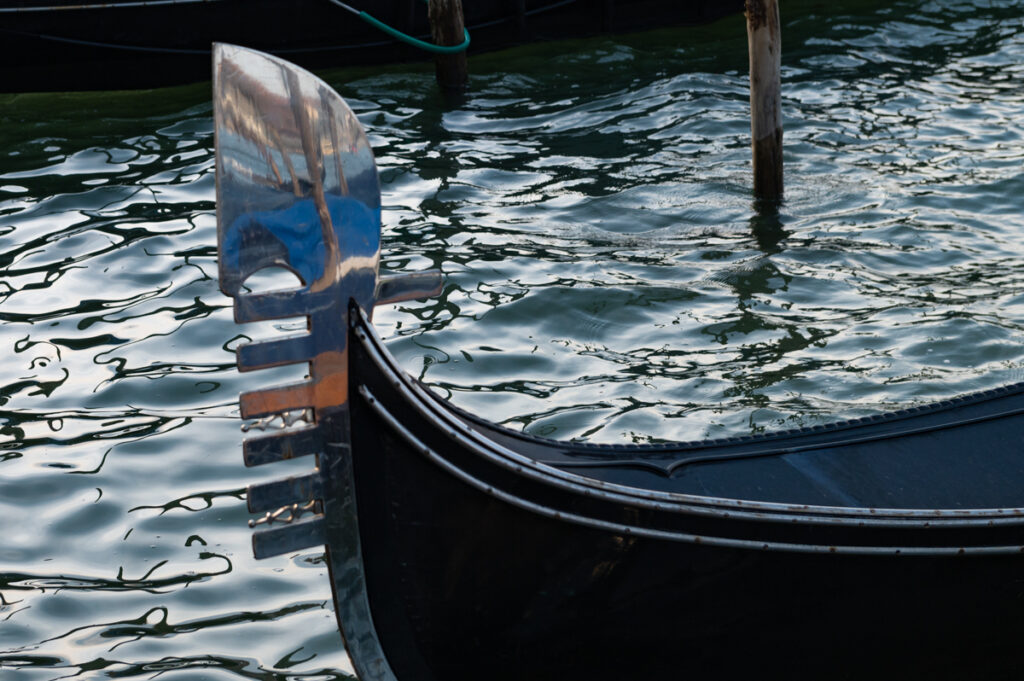
The end of the Repubblica Serenissima – in 1797 by the hands of Napoleon – also brought about the end of the boat songs. Rousseau’s Dictionary of Music had become widespread in Europe, and, the singing Gondoliers enhanced Venice’s attraction as a tourist destination. The boat songs lost their authenticity, or were forgotten. O Sole Mio – the song nowadays commonly associated with the Venetian gondoliers – is a Neapolitan tune.
Around the same time, composers of serious music turned towards the songs from the boats. Even the teutonic Wagner caught the barcarolle bug. In 1858, while visiting Venice, he wrote into his diary: “Those melodies, profoundly melancholic, sung in a sonorous and powerful voice have given me a deep emotion. Magnificent.” Offenbach, Faures, and even Schubert, who never visited Venice, started writing beautiful and sophisticated barcarolles – by definition a melancholy piece whose rhythm conveyed the swaying motion of the waves. The oral tradition of the gondoliers was re-imagined on sheet music across Europe, while the gondoliers themselves fell silent. Friedrich Nietzsche, another music loving German, wrote:
Gondolas, light, music –
Drunkenly swim into the dawn…
My soul, a stringed game,
Sings to itself, plucks invisibly,
A homely gondola song,
Trembles with colourful happiness.
— Was anyone listening?
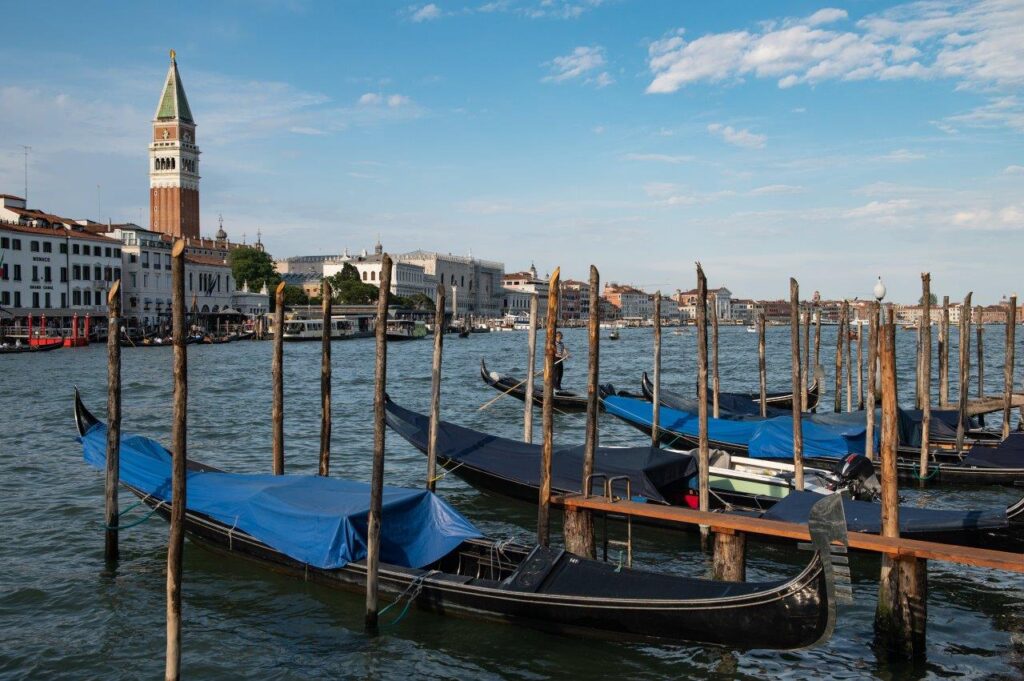
If a tourist now requests music accompaniment on his gondola trip he can pay an extra for a singer and another musician, most likely an accordion player. Therefore the travelers can request songs from an international songbook. That’s amore, for example, at €120 an hour.
To a contemporary visitor, Venice is hard to find behind the canvas of commercialism. History too often remains hidden behind the throngs of tourists. Alas, Venice is sinking. But maybe swan song is now what Gerusalemma Liberata was once, and it’s what the green waves are whispering as they turn black in the nocturnal city. Venice is sinking, but Venice still is beautiful. Already in 1812 Lord Byron wrote:
In Venice, Tasso’s echoes are no more,
And silent rows the songless gondolier;
Her palaces are crumbling to the shore,
And music meets not always now the ear:
Those days are gone – but beauty still is here.
States fall, arts fade – but Nature doth not die,
Nor yet forget how Venice once was dear,
The pleasant place of all festivity,
The revel of the earth, the masque of Italy!
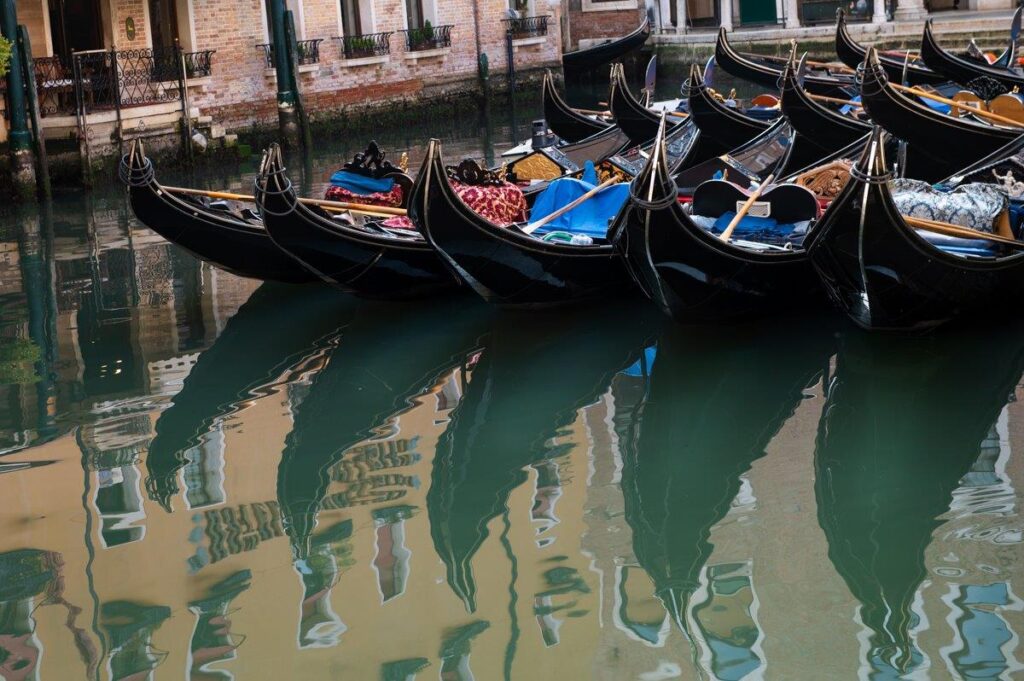
But maybe, the city is music itself, as Brodsky wrote.
“It comes to you in tidal scores,, in bars of canals, with innumerable obbligati of bridges, mullioned windows, or curved crownings of Coducci cathedrals, not to mention the violin necks of gondolas. In fact, the whole city, especially at night, resembles a gigantic orchestra, with dimly lit music stands of palazzi, with a restless chorues of waves, with the falsetto of a star in the winter sky. The music is, of course, greater than the band, and no hand can turn the page.”
